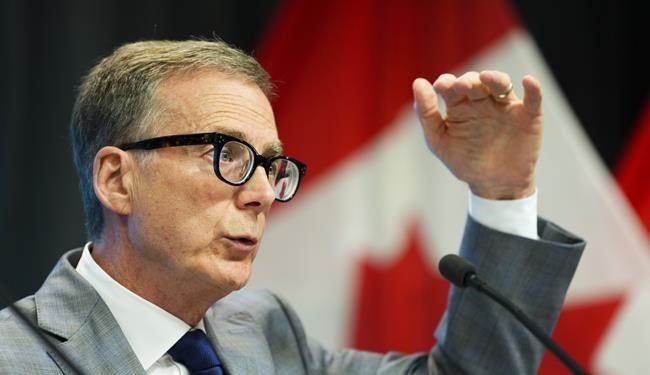OTTAWA — Canada's inflation rate has returned to the country's target range after a tumultuous couple of years of soaring prices.
Statistics Canada reported on Tuesday that inflation fell to 2.8 per cent in June, down significantly from the eye-popping peak of 8.1 per cent reached last summer.
That's within the country's one to three per cent inflation target and, as Finance Minister Chrystia Freeland has boasted, the lowest inflation rate in the G7.
But despite the good news, the Bank of Canada is still in inflation-fighting mode and seems more likely to raise interest rates further than cut them anytime soon.
Earlier this month, the central bank raised its key interest rate again by a quarter percentage point, bringing its key rate to five per cent. At the time, the most recent inflation reading showed the annual rate had fallen to 3.4 per cent in May.
Though the decline in inflation was praised by governor Tiff Macklem, he also issued a warning that the central bank is ready to raise interest rates further if needed.
Given the progress made so far, the Bank of Canada's hawkishness might seem confusing: why raise interest rates even more when inflation has fallen so significantly?
After all, economists know there's a lag in monetary policy, which means interest rate hikes can take between one to two years to fully affect the economy.
A key element of the answer lies in the Bank of Canada's commitment to hit the midpoint of its target range.
The central bank has been adamant that it's aiming for two per cent inflation: not more and not less.
New projections from the Bank of Canada suggest the steady progress made on inflation over the last year will stall. The central bank now expects Canada's inflation rate to hover around three per cent over the next year, before falling to two per cent by mid-2025.
That means it will take six months longer than the bank previously expected to get back to target.
The Bank of Canada justified its last rate hike in part by pointing to this new projection, which also signals that interest rates are likely to stay higher for longer.
Private-sector economists also expect getting inflation back to two per cent will be challenging and will entail some hiccups along the way.
That's because core measures of inflation — which strip out volatility and are better at gauging underlying price pressures — are still high.
Lower gasoline prices are responsible for much of the deceleration in inflation so far, while other prices are still rising rapidly. Excluding gasoline prices, Canada's inflation rate would have been 4.0 per cent in June.
The Bank of Canada's two preferred core measures of inflation that it tracks closely also show inflation hasn't eased as much as it might appear, hovering at 3.7 and 3.9 per cent last month.
And with the economy so far outperforming what the central bank and forecasters were anticipating for 2023, the Bank of Canada says it felt it needed to take rates higher.
The central bank's aggressive approach has not been without pushback, particularly from labour groups and left-leaning economists who have called out the rate hikes as punishment for workers.
Higher interest rates are meant to slow the economy down, which would ultimately come with some job losses.
That's in addition to the hurt being felt by many homeowners, such as those with variable-rate mortgages or those with fixed-rate mortgages that are coming up on renewal.
In a client note sent Friday, CIBC deputy chief economist Benjamin Tal lays out why the Bank of Canada would prefer being more hawkish than dovish with inflation.
"Give the Bank of Canada two choices: inflation or a recession, and the Bank will take a recession any day. The reason is that central banks have a lot of experience and effective tools to fight recessions, while rising inflation expectations are a central banker’s worst nightmare," Tal wrote.
"The practical implication of this asymmetric game is that the Bank of Canada is biased."
The Bank of Canada has repeatedly admitted to that bias in its monetary policy reports, where it lays out risks to its forecasts. It has said on multiple occasions that it's more concerned that inflation might be stickier than expected than it is about the risk of a global recession, given inflation was already high.
Tal said that bias likely drove the Bank of Canada to overshoot with interest rates as early as in June. But as signs of a weakening economy grow, the economist said the central bank will have to back off at some point.
"The Bank of Canada might hike again in September, but soon enough the current disinflationary forces will be too noticeable to ignore, even for a biased bank."
This report by The Canadian Press was first published July 23, 2023.
Nojoud Al Mallees, The Canadian Press



